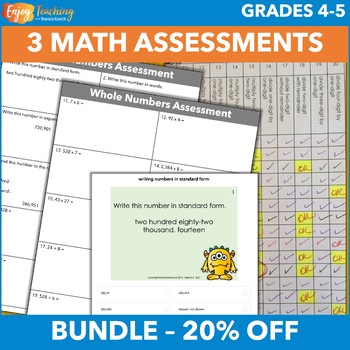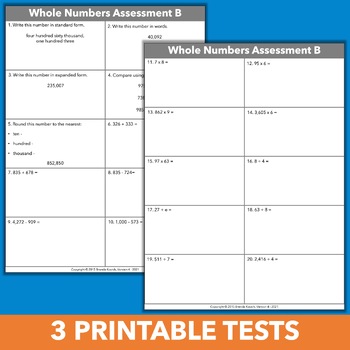Math Whole Number Assessments Bundle - Printable & Self-Checking Digital Tests
- Zip
- Easel Activity
- Easel Assessment
Products in this Bundle (3)
Description
Three tests provide fourth and fifth grade whole number assessment throughout the year. Problems address numbers in base ten standards that ask students to write, compare, round, add, subtract, multiply, and divide. Grab this bundle to inform your math instruction.
Open the previews to take a closer look.
Each assessment includes 20 parallel math questions. You can use them to collect data at the beginning, middle, and end of the year; as test prep; or for practice.
Problems are available in four formats:
- printable and digital worksheets
- self-checking Easel Assessments
- task cards
Questions are the same in all formats.
Each standard has been carefully deconstructed. This allows you to identify which numeration and basic operations sub-skills a student has mastered:
- writing multi-digit numbers using numbers in standard form, words, and expanded form
- comparing with <, >, and =
- rounding to the nearest ten, hundred, and thousand
- adding with and without regrouping
- subtracting with and without regrouping
- subtracting across zeros
- multiplying one, two, three, or four digits by one digit
- multiplying two digits by two digits
- dividing one, two, three, and four digits by one digit
Standards checklists for individual students and class record-keeping are provided with each set.
To recognize student achievement and communicate with parents, award cards and a certificate can be found at the end of each file.
What’s Included:
- Three 2-page printable assessments
- Three 2-page digital tests (Easel Activities)
- Three sets of 20 task cards
- “I Can” checklist - Each student can track his/her own progress.
- Teacher checklist – The checklist lets you plan grouping or remediation. Keep it handy until all students have mastered every concept.
- Themed award cards – Acknowledge mastery with these cute award cards.
- Themed checklist – Communicate with parents. At a glance, they’ll know which skills to practice at home.
- Answer keys
Enjoy teaching!
Brenda Kovich





